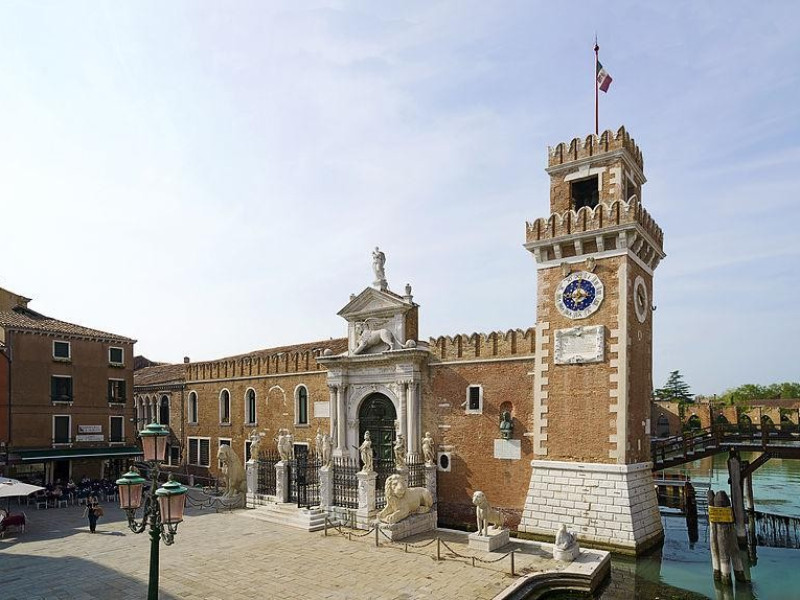Arsenale di Venezia
The Venetian Arsenal (Italian: Arsenale di Venezia) was a complex of state-owned shipyards and armories clustered together in the Republic of Venice in northern Italy. It was responsible for the bulk of Venice's naval power during the middle part of the second millennium AD. It was "one of the earliest large-scale industrial enterprises in history".
Construction of the Arsenal began around 1104, during Venice's republican era. It became the largest industrial complex in Europe prior to the Industrial Revolution, spanning an area of about 45 ha (110 acres), or about fifteen percent of Venice.Surrounded by a 2 mi (3.2 km) rampart, laborers and shipbuilders regularly worked within the Arsenal, building ships that sailed from the city's port. With high walls shielding the Arsenal from public view and guards protecting its perimeter, different areas of the Arsenal each produced a particular prefabricated ship part or other maritime implement, such as munitions, rope, and rigging. These parts could then be assembled into a ship in as little as one day. An exclusive forest owned by the Arsenal navy, in the Montello hills area of Veneto, provided the Arsenal's wood supply.
The Arsenal produced the majority of Venice's maritime trading vessels, which generated much of the city's economic wealth and power, lasting until the fall of the republic to Napoleon's conquest of the area in 1797. It is located in the Castello district of Venice, and it is now owned by the state.
The Byzantine-style establishment may have existed as early as the eighth century, though the present structure is usually said to have been begun in 1104 during the reign of Ordelafo Faliero, although there is no evidence for such a precise date. It definitely existed by the early 13th century.
Initially the state dockyard worked merely to maintain privately built naval ships, but in 1320 the Arsenale Nuovo (Italian: New Arsenal) was built, much larger than the original. It enabled all the state's navy and the larger merchant ships to be both constructed and maintained in one place. The Arsenal incidentally became an important center for rope manufacture, and housing for the arsenal workers grew up outside its walls.
Venice developed methods of mass-producing warships in the Arsenal, including the frame-first system to replace the Roman hull-first practice. This new system was much faster and required less wood. At the peak of its efficiency in the early sixteenth century, the Arsenal employed some 16,000 people who apparently were able to produce nearly one ship each day, and could fit out, arm, and provision a newly built galley with standardized parts on a production-line basis not seen again until the Industrial Revolution.
View of the Entrance to the Arsenal by Canaletto, 1732.
The staff of the Arsenal also developed new firearms at an early date, beginning with bombards in the 1370s and numerous small arms for use against the Genoese a few years later. The muzzle velocity of handguns was improved beyond that of the crossbow, creating armor-piercing rounds. Arsenal-produced arms were also noteworthy for their multi-purpose utility; the Venetian condottieri leader, Bartolomeo Colleoni, is usually given credit as being the first to mount the Arsenal's new lighter-weight artillery on mobile carriages for field use.
The Arsenal's main gate, the Porta Magna, was built around 1460 and was the first Classical revival structure built in Venice. It was perhaps built by Antonio Gambello from a design by Jacopo Bellini. Two lions taken from Greece situated beside it were added in 1687. One of the lions, known as the Piraeus Lion, has runic defacements carved in it by invading Scandinavian mercenaries during the 11th century.
In the late 16th century, the Arsenal's designers experimented with larger ships as platforms for heavy naval guns. The largest was the galleass, already used at the Battle of Lepanto against the Ottoman Turks, and developed from the old merchanting "great galley". It was huge, propelled by both sails and oars, with guns mounted on wheeled carriages along the sides in the modern fashion. It was slow and unwieldy in battle, however, and few were ever built. The galleon, also developed at the Arsenal, was an armed sailing ship, a slimmer version of the merchant "round ship". It was useful in major naval battles, but not in the small bays and off the extensive lee shores of the Dalmatian coast.
Significant parts of the Arsenal were destroyed under Napoleonic rule, and later rebuilt to enable the Arsenal's present use as a naval base. It is also used as a research center, an exhibition venue during the Venice Biennale and is home to a historic boat preservation center.
Fonte: Wikipedia

